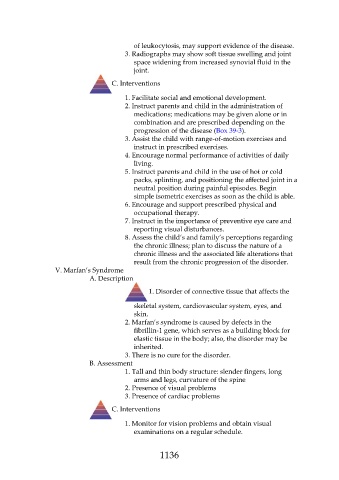Page 1136 - Saunders Comprehensive Review For NCLEX-RN
P. 1136
of leukocytosis, may support evidence of the disease.
3. Radiographs may show soft tissue swelling and joint
space widening from increased synovial fluid in the
joint.
C. Interventions
1. Facilitate social and emotional development.
2. Instruct parents and child in the administration of
medications; medications may be given alone or in
combination and are prescribed depending on the
progression of the disease (Box 39-3).
3. Assist the child with range-of-motion exercises and
instruct in prescribed exercises.
4. Encourage normal performance of activities of daily
living.
5. Instruct parents and child in the use of hot or cold
packs, splinting, and positioning the affected joint in a
neutral position during painful episodes. Begin
simple isometric exercises as soon as the child is able.
6. Encourage and support prescribed physical and
occupational therapy.
7. Instruct in the importance of preventive eye care and
reporting visual disturbances.
8. Assess the child’s and family’s perceptions regarding
the chronic illness; plan to discuss the nature of a
chronic illness and the associated life alterations that
result from the chronic progression of the disorder.
V. Marfan’s Syndrome
A. Description
1. Disorder of connective tissue that affects the
skeletal system, cardiovascular system, eyes, and
skin.
2. Marfan’s syndrome is caused by defects in the
fibrillin-1 gene, which serves as a building block for
elastic tissue in the body; also, the disorder may be
inherited.
3. There is no cure for the disorder.
B. Assessment
1. Tall and thin body structure: slender fingers, long
arms and legs, curvature of the spine
2. Presence of visual problems
3. Presence of cardiac problems
C. Interventions
1. Monitor for vision problems and obtain visual
examinations on a regular schedule.
1136

